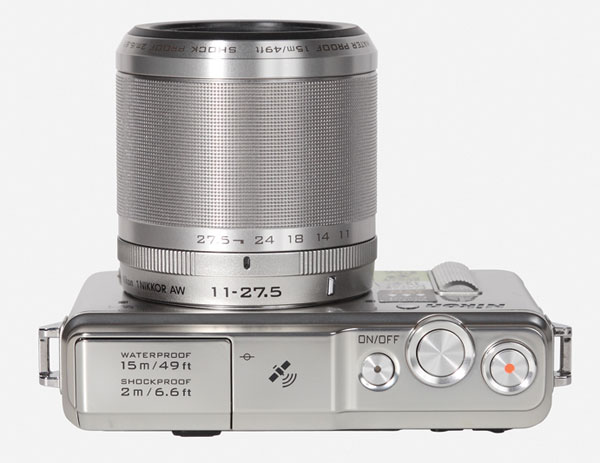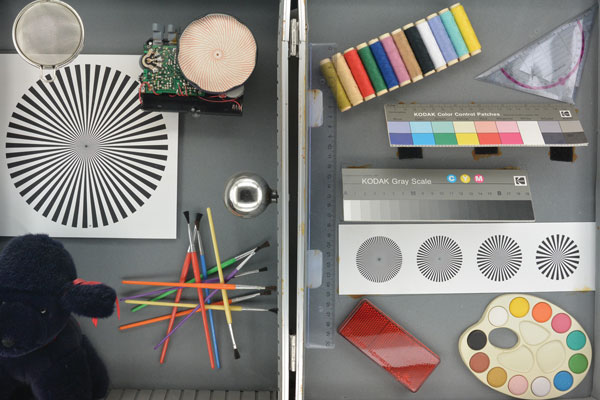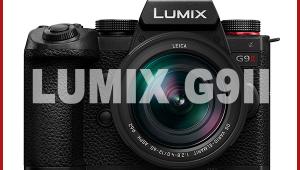Nikon 1 AW1 Mirrorless Camera Review
The Nikon 1 AW1 is the first digital compact system camera that can be used for diving or other active sports without an additional protective case. Protected by a stainless steel front cover, all function elements, card slots, and interfaces are protected by sealed covers. While the 1 AW1 can be used with all lenses of the Nikon 1 system, using it underwater and in similar adverse conditions requires the use of special lenses. Nikon offers a standard kit lens with a focal length of 11-27.5mm (29.7-74.25mm, 35mm film equivalent) that is protected by sealing gaskets and therefore can be used underwater. The second underwater lens is the 1 Nikkor AW 10mm f/2.8.





When the photographer mounts the lens the camera will check the sealant protection and show a warning on the LCD screen if the seal between the gasket of the camera and the gasket of the lens system isn’t perfect.
Nikon developed special handling options for use underwater. The camera uses no setup dials; it only has a standard four-way control field. The “magnifier” switch and the exposure mode switch on the back are used as additional right/left or plus/minus switches. You can use these function buttons to change the program shift in P mode, for example. Perhaps the most extraordinary handling feature is the “Action Control” system. By pressing the button on the right side of the back (above the play button), the camera shows six areas on a compass-like display. Each area defines an image mode like “Auto” or “Advanced Movie” mode. A cursor line is also shown and is aligned vertically downward (controlled by the gyro sensor of the camera). By rotating the camera you can change the image mode as well as individual parameters very easily. This is very helpful when shooting underwater or when wearing gloves in the snow.
The camera offers an integrated GPS system and is able to record the GPS data into the EXIF information of each image. It offers a pop-up flash, which helps to illuminate underwater scenes. (A pop-up flash is very unusual for rugged compact cameras, which mostly use a fixed flash system on the front of the camera.)
The Nikon 1 AW1 uses a large LCD screen (3”) on the back, which is fixed and has a resolution of 921,000 RGB dots. It is a key element for camera handling and shows a clearly structured menu system.
Comments On Still Image Quality
Color: The color results are very good. The camera showed very realistic colors with a low error level. The blue nuances are slightly boosted (typical for Nikon cameras) and the white balance system caused a bit of a cooler look, yet shifted the brightest gray areas of the test pattern in the green and yellow direction. Skin tones are reproduced absolutely perfectly. Colors 1 and 2 of the test chart are located exactly on their given values. This high quality of skin tone reproduction is matched by their smooth, silky look.

Sharpness: The camera showed a good performance in the resolution tests and reproduced the test chart with 2739 of 3072 lines (sensor resolution) per picture height. The JPEG images are optimized by a noticeable sharpness filtering, which causes some overshot effects and can create halo and double contour lines on contrast lines. The camera tends to yield slight moiré effects, which we noticed in the hair structure of the model test shot.
Noise: The camera showed very good results in our noise and dynamic range tests. The luminance noise level is very low; it stays way below the 1.0 percent frontier even at the highest ISO speed settings. Color noise is also low, reduced by a very intense filtering system. This causes the standard anti-noise filter artifacts, noticeable in images taken with ISO 3200 and higher. Between ISO 160 and ISO 800 dynamic range results are very good (nearly 10 f/stops, maximum of 10.6 f/stops) but decline quickly at higher ISO settings.

Comments On Video Functions
The camera delivers Full HD mode with 1920x1080 pixels and 30 (29.97) frames per second. It also can record with higher frame rates (up to 60 frames), but the single frames are recorded in interlaced format (which is better for presentation on TV screens, but less so for using higher frame rates to create slow motion effects, for example).
The camera uses MP4/H.264 compression and records in Apple’s MOV file format. Most software players and TV screens with SD card slots are able to present these movies directly, and most editing software is able to work with these files flawlessly.
The camera allows users to shoot videos in all exposure modes. The integrated image stabilizer (sensor shift) worked well during photo shoots and especially in video mode. It helped to create very smooth video even when taking panning shots. The camera offers an HDMI interface for video presentation on HDTVs, but a microphone port for better sound recording is missing. However, this is understandable because the camera does not use any interface that isn’t absolutely necessary (and that might pose the potential for a water leak). The same applies to the missing swivel LCD screen, which would be helpful for recording videos, but could also pose a potential problem.
The ability to shoot in all manual exposure modes means the videographer can make settings suitable for even very complex scenes. Handling is easy, but all settings have to be done with the help of the LCD screen menu, which is less comfortable than a camera with an aperture lens ring and setup dials. But this is also the trade-off for its underwater capabilities.

Comments On Video Quality
The Nikon 1 AW1 creates videos with very realistic colors. The standard test chart was reproduced with a very low error level—only the full cyan pattern shows an extreme shift into the center of the result chart and therefore a darker, less saturated color than its given value.
The white balance system worked well and showed only a slight shift of the brightest gray pattern into the yellow and green direction, while the other patterns are located exactly in the center of the result chart. Indeed, the results are even better than the color reproduction when taking still images. The camera also showed a remarkably high result in our video resolution test. It gains a maximum of 737 lines per picture height (Full HD resolution image with 1080 horizontal lines), which is a very good result for a photo camera that additionally records video.

Scorecard
Pro
+ Waterproof without additional housing
+ Very robust body (stainless steel)
+ Very good image quality, very realistic color reproduction
Con
- Missing electronic viewfinder
- Missing swivel LCD
- Missing accessory shoe for additional flash systems or studio flash systems
- Missing WLAN
The Nikon 1 AW1 with the 1 Nikkor11-27.5mm f/3.5-5.6 kit lens has a list price of $799.95. For more information, visit www.nikonusa.com.
Lab results and test images by BetterNet, our TIPA-affiliated testing lab. Edited by George Schaub.
- Log in or register to post comments

















































